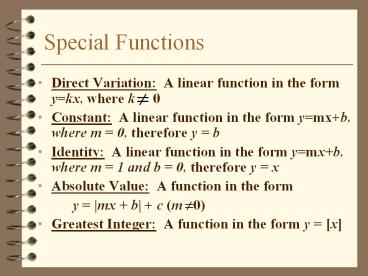Special%20Functions PowerPoint PPT Presentation
Title: Special%20Functions
1
Special Functions
- Direct Variation A linear function in the form
ykx, where k 0 - Constant A linear function in the form ymxb,
where m 0, therefore y b - Identity A linear function in the form ymxb,
where m 1 and b 0, therefore y x - Absolute Value A function in the form
- y mx b c (m 0)
- Greatest Integer A function in the form y x
2
Direct Variation Function A linear
function in the form y kx, where k 0
3
Constant Function A linear function in the form
y mx b, where m 0, therefore y b
4
Identity Function A linear function in the form
y mx b, where m 1 and b 0, therefore y
x
5
Absolute Value Function A function in the form
y mx b c (m 0)
- Ex 1 Graph y x by completing a table of
values
y -2 2 y -1 1 y 0 0 y 1 1
y 2 2
The vertex, or minimum point, is (0, 0).
6
Practice Problems
- Identify each of the following as constant,
identity, or direct variation function - a. f(x) -½x b. g(x) x
- c. h(x) 7 d. f(x) 9x
7
Integers
- The integers (from the Latin integer, literally
"untouched", hence "whole - Are natural numbers including 0 (0, 1, 2, 3, ...)
and their negatives (0, -1, -2, -3, ...) - For example, 65, 7, and -756 are integers 1.6
and 1½ are not integers. - In other terms, integers are the numbers one can
count with items such as apples or fingers, and
their negatives, as well as 0. - Symbol is Z which stands for Zahlen (German for
numbers)
8
Greatest Integer Function A function in the
form y x
- Note x means the greatest integer less than or
equal to x. For - example, the largest integer less than or equal
to 3.5 is 3. The largest - integer less than or equal to -4.5 is -4.
The open circles mean that the particular point
is not included
9
Greatest Integer Function
- x means the largest integer less than or equal
to x - Examples 8.2 8 3.9 3
5.0 5 7.6 7
Example 1.97 1
There are many integers less than 1.97 1, 0,
-1, -2, -3, -4, Of all of them, 1 is the
greatest.
There are many integers less than -1.97 -2,
-3, -4, -5, -6, Of all of them, -2 is the
greatest.
Example -1.97 -2
10
It may be helpful to visualize this function a
little more clearly by using a number line.
Example 6.31 6
Example -6.31 -7
When you use this function, the answer is the
integer on the immediate left on the number line.
There is one exception. When the function acts
on a number that is itself an integer. The
answer is itself.
Example 5 5
Example -5 -5
11
Lets graph f(x) x
To see what the graph looks like, it is necessary
to determine some ordered pairs which can be
determined with a table of values.
If we only choose integer values for x then we
will not really see the function manifest itself.
To do this we need to choose non-integer values.
12
y
x
13
When all these points are connected the graph
looks something like a series of steps.
Notice that the left of each step begins with a
closed (inclusive) point but the right of each
step ends with an open (excluding point)
For this reason it is sometimes called the STEP
FUNCTION.
We dont include the last (most right) x-value on
each step
14
Rather than place a long series of points on the
graph, a line segment can be drawn for each step
as shown to the right.
15
This is a rather tedious way to construct a graph
and for this reason there is a more efficient way
to construct it. Basically the greatest integer
function can be presented with 4 parameters, as
shown below.
f(x) abx - h k
By observing the impact of these parameters, we
can use them to predict the shape of the graph.
16
f(x) abx - h k
In these 3 examples, parameter a is changed.
As a increases, the distance between the steps
increases.
Vertical distance between Steps a
17
When a is negative, notice that the slope of
the steps is changed. Downstairs instead of
upstairs.
Vertical distance between Steps a
18
- Graph y x 2 by completing a table of values
19
As b is increased from 1 to 2, each step gets
shorter. Then as it is decreased to 0.5, the
steps get longer.
20
Five Steps to Construct Greatest Integer Graph
f(x) abx - h k
1. Starting point f(0)
21
f(x) 3-x 3 5
a 3 b -1 h 3 k 5
1. Starting point (0,-4) f(0)
3-(0)-35 3(-3)5 -4
22
Practice problems
- Identify each of the following as constant,
identity, direct variation, absolute value, or
greatest integer function - h(x) x 6 e. f(x) 3-x 1
- f(x) -½x f. g(x) x
- g(x) 2x g. h(x) 2 5x
- h(x) 7 h. f(x) 9x
- Graph the equation y x 6
- Hint When completing the table of values,
you will need some bigger values for x, like x
6, x 7, x 8
23
Answers
- a) greatest integer function
- b) direct variation
- c) absolute value
- d) constant
- e) absolute value
- f) identity
- g) greatest integer function
- h) direct variation

